| Article ID | Journal | Published Year | Pages | File Type |
|---|---|---|---|---|
| 1325791 | Journal of Organometallic Chemistry | 2010 | 5 Pages |
Aromatic [CpCo(S2C2(R)(H))] complexes (R = Me (1) and Ph (5)) reacted with 2,2′-dibenzothiazolyl disulfide (2, R’SSR’ (R′ = 2-benzothiazolyl)) as a sulfur-centered radical source to form some radical substitution products. 2-Benzothiazolylthiyl radical (R’S•) was substituted on the dithiolene ring or on the Me group of 1 to give [CpCo(S2C2(Me)(SR’))] (3) or [CpCo(S2C2(CH2SR’)(H))] (4), respectively. The reaction of 5 with 2 gave two different substitution products on the dithiolene ring but they were structural isomers. One was the substitution product [CpCo(S2C2(Ph)(SR’))] (6) by the R’S• radical substitution (S-substituted product), and the other was N-substituted product (7). 7 was formed by a nitrogen-centered radical that is a resonant species of the 2-benzothiazolylthiyl radical. Conventional heating, photochemical and microwave-enhanced reactions were performed. The molecular structures of 3, 4 and 7 were determined by X-ray diffraction studies.
Graphical abstractAromatic [CpCo(S2C2(R)(H))] complexes (R = Me and Ph) reacted with 2,2′-dibenzothiazolyl disulfide (R’SSR’ (R′ = 2-benzothiazolyl)) as a sulfur-centered radical source to form some radical substitution products by 2-benzothiazolylthiyl radical (R′S•). The R′S• radical was substituted on the dithiolene ring or on the Me group (S-substituted products). An N-substituted product was also formed by a nitrogen-centered radical that is a resonant species of the 2-benzothiazolylthiyl radical. Conventional heating, photochemical and microwave-enhanced reactions were performed.Figure optionsDownload full-size imageDownload as PowerPoint slide
